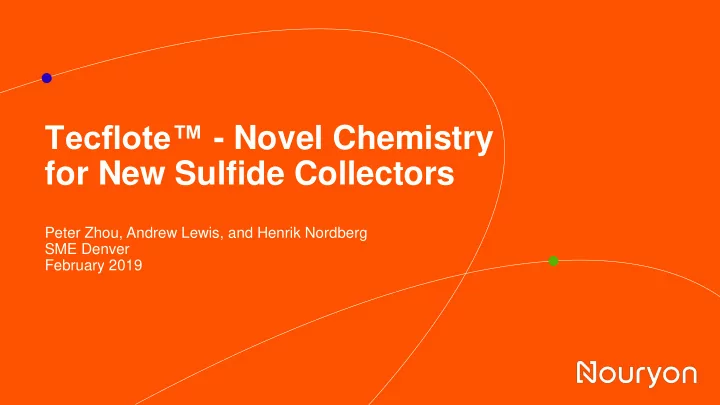

Tecflote™ - Novel Chemistry for New Sulfide Collectors Peter Zhou, Andrew Lewis, and Henrik Nordberg SME Denver February 2019
Agenda ❖ Nouryon ❖ Thiol-based collectors ❖ Tecflote – non-thiol new chemistry ❖ Collector chemistry ❖ Flotation mechanism ❖ Flotation performance ❖ Technical summary ❖ Conclusions Surface Chemistry | Mining 2
Nouryon – Former AkzoNobel Specialty Chemicals Business Units - Surface Chemistry - Ethylene and Sulfur Derivatives - Polymer Chemistry - Industrial Chemicals - Pulp & Performance Chemicals Surface Chemistry | Mining 3
Main mineral markets we serve New Phosphate Iron Ore Copper Sulfide Calcite Potash Surface Chemistry | Mining 4
Sulfide Flotation Chemistry of historical sulfide collectors 1882 Xanthate was first made by Zeise 1924 Xanthate first used in flotation 1928 Dithiophosphate first patented for flotation 1954 Thionocarbamate first patented for flotation Collector developments historically focused around thiol-based chemistry Tecflote™: a novel family of sulfide ore collectors Surface Chemistry | Mining 5
Tecflote™ – Nitrile Chemistry Tecflote S10 Tecflote S11 R ≈ C14 -C20 C20-C40 Solid Liquid Insoluble in water Insoluble in water For: Cu, Zn, Pb, Mo, Ni For: Cu, Zn, Pb, Mo, Ni Liquid version is available Surface Chemistry | Mining 6
Tecflote collectors – key benefits ▪ Tecflote: designed for flotation of sulfide ores ▪ Unique features vs. traditional thiol collectors: ❖ Completely different particle / bubble attachment mechanism ❖ Significantly better performance (selectivity and recovery) for Au and Ag – Nitriles strong affinity to Au and PGM elements ❖ Excellent discrimination against pyrite at natural pH without lime ❖ Cu flotation: distinguishing feature of steep grade recovery curve ❖ Excellent performance for hypogene ores Surface Chemistry | Mining 7
Particle attachment Different particle / bubble attachment vs. ToF-SIMS spectra of individual floated particles conventional thiol collectors 16 O - CN - ion fragment from 17 OH - chalcopyrite surfaces Nitrile functional group: - C≡N in the concentrate Intensity • rich electrons / electron pairs 26 35 CN - Cl - • strong bonding to transition metals 37 Cl - Atomic mass units (AMU) 321 Surface analysis (ToF-SIMS): Tecflote selectively attaching to the Cu particles (chalcopyrite) Intensity - Surface Chemistry | Mining 8
Bubble attachment Different particle / bubble attachment vs. conventional thiol collectors -CN / nitrile for particle attachment Hydrophobic tail for bubble attachment Highly surface active • Tecflote S10 at the water/air interface • : 72 mN/M 52 mN/M in seconds • Quickly spread on the air-water interface (Wilhelmy plate) • No migration of S10 in water: no change for an air bubble in S10 solution (pendant drop) Low solubility • Tecflote S10 and S11: nearly insoluble in water • Tecflote S11: <1.5µg/L (ppb) – below detection limit Surface Chemistry | Mining 9
Bubble attachment A completely different particle/bubble attachment mechanism compared to conventional collectors Tecflote is surface active and spreads easily on the air-water interface How can an turbulent pulp zone the froth zone insoluble surfactant be The collector attaches to the particle after it a collector? collides with the bubble experiments with a turbulent pulp without air showed no mineral collector attachment Surface Chemistry | Mining 10
Flotation Performance ❖ Significantly better selectivity and recovery for Au and Ag vs. thiol collectors (PAX) ❖ nitriles have an affinity to Au and PGM elements Improved ❖ Excellent discrimination against pyrite Performance (to suppress pyrite) at natural pH without lime for many ore types Au recovery versus total S recovery Feed: Cu 0.35%, Au 2.5ppm, S as pyrite 7% Rougher + cleaning Surface Chemistry | Mining 11
Flotation Performance, Copper Improved Performance Steep grade recovery curve Mine site laboratory Feed: Cu 0.15%, total S 2.0%, Mo 0.002% Rougher + re-grind + cleaning Surface Chemistry | Mining 12
Flotation Performance – Copper versus pyrite Excellent discrimination against pyrite Improved Performance with reduced lime Mine site laboratory Feed: Cu 0.15%, total S 2.0%, Mo 0.002% Rougher + re-grind + cleaning Surface Chemistry | Mining 13
Flotation Performance, Molybdenum Improved Performance Tecflote is suitable for other sulfides, e.g. Mo, Zn Mine site laboratory Feed: Cu 0.15%, total S 2.0%, Mo 0.002% Rougher + re-grind + cleaning Surface Chemistry | Mining 14
Flotation Performance, Zinc Improved Performance Tecflote is suitable for other sulfides, e.g. Mo, Zn Zn grade and recovery, no lime Feed: Zn 1.8%, total S 2.2% Rougher + cleaning Surface Chemistry | Mining 15
Technical Summary Behaviors of Tecflote in flotation dependent on the collector solubility. Collector attaching to the mineral particles at the air / water interface, not from dissolved collector molecules in the pulp Tecflote: significantly good performance at rejecting pyrite and upgrading chalcopyrite. Also valid for bornite, sphalerite, galena and pentlandite, through the cleaner steps Every ore and plant process is unique; customized collector systems for optimized performance The steep grade recovery curve benefit at the cleaning steps Better results achievable through scavenger steps and mixed collectors at most plants Surface Chemistry | Mining 16
Conclusion Steep grade Unique particle / bubble attachment recovery mechanism curve Your partner Selectivity in essential chemistry against pyrite for a sustainable future Excellent performance for hypogene ore types Surface Chemistry | Mining 17
Thank you for your attention Peter Zhou Nouryon, Surface Chemistry 281 Fields Lane, Brewster NY 10509, USA Tel: 1 - 845 276 8310, E-mail: Peter.Zhou@Nouryon.com Surface Chemistry | Mining 18
Recommend
More recommend